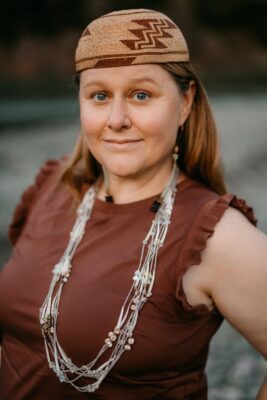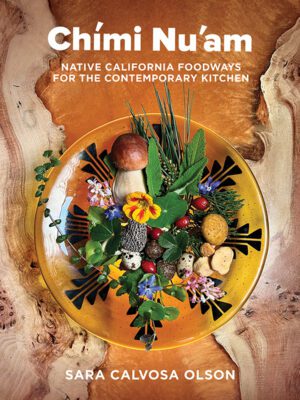Name: Sara Calvosa Olson
Location: Huiman Coast Miwok Land (Mill Valley, CA)
Education/background: Author, Chími Nu’am: Native California Foodways for the Contemporary Kitchen, 2023 Heyday
Tribe: Karuk

What led to your passion for Indigenous foods?
It started very simply, I was raising my children away from Karuk community and wanted to make sure that they were developing a taste for foods that are very different than the regular homogenous western diet foods. I wanted them to appreciate bitterness and earthiness and fishy things, to look around them and see where they fit into relationship with our environment. I was raised in a sort of hybrid way—we often depended on commodity boxes of foods growing up, but we also had a big garden, occasionally hunting, fishing, trading in community, and food was integral to celebrations and the way we showed love as a family.
I think that I have always felt called to show love in acts of service, and connecting my sons to our foodways was a natural entry point for me. I loved making their baby foods, and I have loved watching them grow into their own relationships with these little relatives. And being able to share the recipes and processes I’ve developed in my own home is really a gift. I’m so surprised and excited when I find people that want to dip their toe into reclaiming these lifeways for themselves in their own way too. My book is really for everybody that wants to get started on this journey that will hopefully lead them to fulfilling their responsibilities and nurturing relationships with their communities and ecosystems.
Why do you think it’s important to make traditional foods accessible for Natives?
Diet-related diseases affecting our communities are a result of ongoing colonization and disconnection. But our traditional foodways were never just disembodied meals, they are intentional in every way. Our connection to these foods is just one part of an entire holistic picture that centers relationship and responsibility and thoughtful observational science. It informs our languages, our art, our spirits, our stories, our governance, our movements, our activism, and advocacy. When we share our foods, we’re sharing all these things with each other. When we put our foods into the hands of our people, we are also making every part of being Indigenous accessible as well.
What is the importance of an indigenous diet for a healthy lifestyle?
I tend to shy away from talking about Indigenous foods in terms of a “healthy lifestyle.” It automatically sets up divisions and can feel like coding for classism in food work. Like the “organic” movement that positions organic food as being the paragon of nutrition virtue, really just ends up giving wealthy people that can afford it another way to flex their privilege while leaving poor communities who don’t have access to those foods out of the conversation.
Our people have been deliberately disconnected from our traditional lands and our traditional foods; many of our communities don’t have access to grocery stores that aren’t hours away. And for many of us, our gathering practices and hunting lifeways have been criminalized, so where does that leave people in pursuit of a “healthy lifestyle?” It’s very complicated and deeply personal. So, I feel like the most important thing I can do is meet people where they’re at. Keep shame out of the conversation. Every NDN knows frybread is unhealthy, they don’t need me to tell them that. But what I can do is help them reconnect to the food all around them, show them how to process it, how to store it, preserve it, and then give them some recipes to use our foods in a way that appeals to their current palates. Slow, meaningful, intentional changes that will last longer and grow into more fulfilling connections, hopefully. If we substitute one cup of acorn flour for white flour, that’s still one less cup of white flour and those cups add up.
What other ways are you involved in the education, restoration and accessibility of traditional Native foods?
I love to put together teaching meal kits for community cooking demonstrations. Getting our foods into the hands of our people so they can reconnect with all of their senses; touching, smelling, seeing how the ingredients behave using different cooking methods and observing their properties with our own eyes. Then cooking together and sharing our stories and results and the ways these little relatives are speaking to us as they nourish our whole body and spirt. I am so grateful to be able to share the little bit that I know and be in community with people reconnecting to these foodways and lifeways.
Currently I’m working on scaling my recipes and food security work to be able to help our communities prepare for and participate in caring for families during life events like births, mourning periods, illness, elder care, etc. Karuk people are generous and spiritual and being able to support other families with that generosity and spirit is challenging when there isn’t enough to go around. But the more we reconnect to our land and our roles, the more abundance we can see around us. I’m finding myself moving toward opportunities to learn about feeding larger groups so I can be more effective when it comes to sharing recipes that can positively impact community food security and traditional food sovereignty.
How can community members be involved and support the cause of restoring and protecting Indigenous food systems?
Non-Native community members can get involved by centering their local Indigenous people and the work that is no doubt already being done by tribal communities in their area. If non-Native foragers would like to learn how to forage in a good way, they can refer to the gathering guide in Chími Nu’am to get some ideas about how to lessen their negative impacts and go forward in a relationship-based way that focuses on reciprocity and the entire Indigenous holistic picture.

